module3musicreading说课稿
- 格式:docx
- 大小:16.34 KB
- 文档页数:5
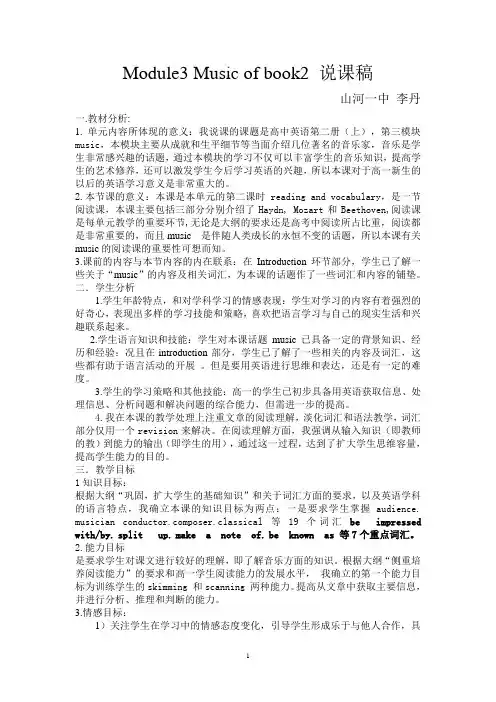
Module3 Music of book2 说课稿山河一中李丹一.教材分析:1. 单元内容所体现的意义:我说课的课题是高中英语第二册(上),第三模块music,本模块主要从成就和生平细节等当面介绍几位著名的音乐家,音乐是学生非常感兴趣的话题,通过本模块的学习不仅可以丰富学生的音乐知识,提高学生的艺术修养,还可以激发学生今后学习英语的兴趣,所以本课对于高一新生的以后的英语学习意义是非常重大的。
2.本节课的意义:本课是本单元的第二课时reading and vocabulary,是一节阅读课,本课主要包括三部分分别介绍了Haydn, Mozart和Beethoven,阅读课是每单元教学的重要环节,无论是大纲的要求还是高考中阅读所占比重,阅读都是非常重要的,而且music是伴随人类成长的永恒不变的话题,所以本课有关music的阅读课的重要性可想而知。
3.课前的内容与本节内容的内在联系:在Introduction环节部分,学生已了解一些关于“music”的内容及相关词汇,为本课的话题作了一些词汇和内容的铺垫。
二.学生分析1.学生年龄特点,和对学科学习的情感表现:学生对学习的内容有着强烈的好奇心,表现出多样的学习技能和策略,喜欢把语言学习与自己的现实生活和兴趣联系起来。
2.学生语言知识和技能:学生对本课话题music已具备一定的背景知识、经历和经验;况且在introduction部分,学生已了解了一些相关的内容及词汇,这些都有助于语言活动的开展。
但是要用英语进行思维和表达,还是有一定的难度。
3.学生的学习策略和其他技能:高一的学生已初步具备用英语获取信息、处理信息、分析问题和解决问题的综合能力,但需进一步的提高。
4.我在本课的教学处理上注重文章的阅读理解,淡化词汇和语法教学,词汇部分仅用一个revision来解决。
在阅读理解方面,我强调从输入知识(即教师的教)到能力的输出(即学生的用),通过这一过程,达到了扩大学生思维容量,提高学生能力的目的。
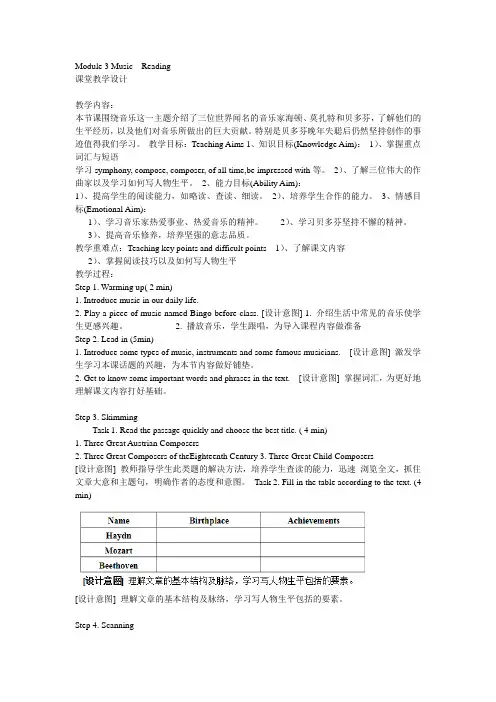
Module 3 Music Reading课堂教学设计教学内容:本节课围绕音乐这一主题介绍了三位世界闻名的音乐家海顿、莫扎特和贝多芬,了解他们的生平经历,以及他们对音乐所做出的巨大贡献。
特别是贝多芬晚年失聪后仍然坚持创作的事迹值得我们学习。
教学目标:Teaching Aims 1、知识目标(Knowledge Aim):1)、掌握重点词汇与短语学习symphony, compose, composer, of all time,be impressed with等。
2)、了解三位伟大的作曲家以及学习如何写人物生平。
2、能力目标(Ability Aim):1)、提高学生的阅读能力,如略读、查读、细读。
2)、培养学生合作的能力。
3、情感目标(Emotional Aim):1)、学习音乐家热爱事业、热爱音乐的精神。
2)、学习贝多芬坚持不懈的精神。
3)、提高音乐修养,培养坚强的意志品质。
教学重难点:Teaching key points and difficult points 1)、了解课文内容2)、掌握阅读技巧以及如何写人物生平教学过程:Step 1. Warming up( 2 min)1. Introduce music in our daily life.2. Play a piece of music named Bingo before class. [设计意图] 1. 介绍生活中常见的音乐使学生更感兴趣。
2. 播放音乐,学生跟唱,为导入课程内容做准备Step 2. Lead in (5min)1. Introduce some types of music, instruments and some famous musicians. [设计意图] 激发学生学习本课话题的兴趣,为本节内容做好铺垫。
2. Get to know some important words and phrases in the text. [设计意图] 掌握词汇,为更好地理解课文内容打好基础。
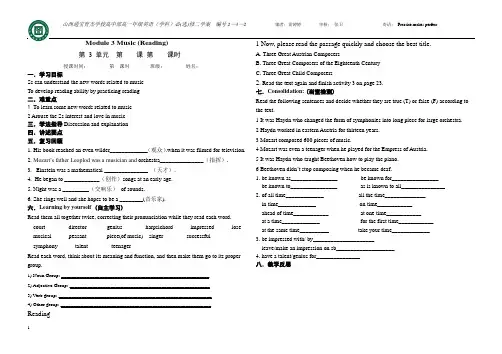
山西通宝育杰学校高中部高一年级英语(学科)必(选)修二学案编号2—3—2 编者:雷婷婷审核:张卫寄语:Practice makes perfect.1Module 3 Music (Reading)第3 单元第课第课时授课时间:第课时班级:姓名:一.学习目标Ss can understand the new words related to musicTo develop reading ability by practicing reading二.难重点1 To learn some new words related to music2 Arouse the Ss interest and love in music三.学法指导Discussion and explanation四.讲述要点五.复习回顾1. His book reached an even wilder_____________(观众).when it was filmed for television.2. Mozart’s father Leoplod was a musician and orchestra_______________(指挥).3. Einstein was a mathematical _______________ (天才).4. He began to ____________(创作)songs at an early age.5. Night was a _________(交响乐)of sounds.6. She sings well and she hopes to be a ________(音乐家).六.Learning by yourself (自主学习)Read them all together twice, correcting their pronunciation while they read each word. court director genius harpsichord impressed lose musical peasant piece(of music) singer successfulsymphony talent teenagerRead each word, think about its meaning and function, and then make them go to its proper group.1) Noun Group: __________________________________________________________2) Adjective Group: _______________________________________________________3) Verb group: ____________________________________________________________4) Other group: ___________________________________________________________Reading 1 Now, please read the passage quickly and choose the best title.A. Three Great Austrian ComposersB. Three Great Composers of the Eighteenth CenturyC. Three Great Child Composers2. Read the text again and finish activity 3 on page 23.七.Consolidation: (当堂检测)Read the following sentences and decide whether they are true (T) or false (F) according to the text.1 It was Haydn who changed the form of symphonies into long piece for large orchestra.2 Haydn worked in eastern Austria for thirteen years.3 Mozart composed 600 pieces of music.4 Mozart was even a teenager when he played for the Empress of Austria.5 It was Haydn who taught Beethoven how to play the piano.6 Beethoven didn’t stop composing when he became deaf.1. be known as________________ be known for________________be known to________________ as is known to all_______________2. of all time_____________ all the time______________in time_____________ on time____________ahead of time____________ at one time____________at a time_____________ for the first time____________at the same time__________ take your time_____________3. be impressed with/ by_____________________leave/make an impression on sb____________________4. have a talent/genius for_______________八.教学反思。
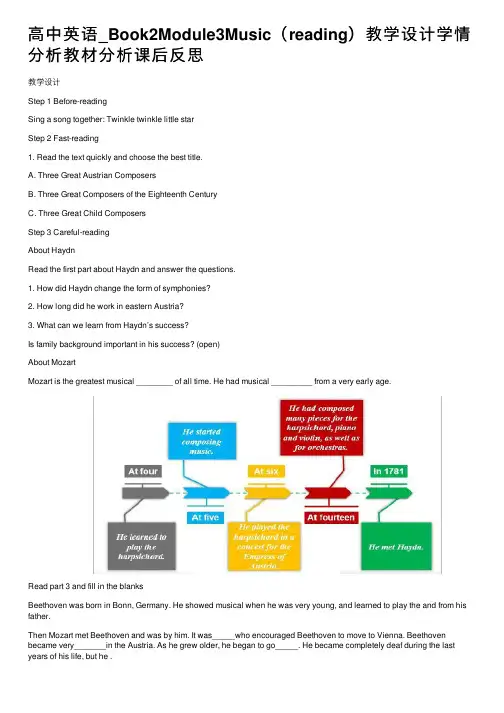
⾼中英语_Book2Module3Music(reading)教学设计学情分析教材分析课后反思教学设计Step 1 Before-readingSing a song together: Twinkle twinkle little starStep 2 Fast-reading1. Read the text quickly and choose the best title.A. Three Great Austrian ComposersB. Three Great Composers of the Eighteenth CenturyC. Three Great Child ComposersStep 3 Careful-readingAbout HaydnRead the first part about Haydn and answer the questions.1. How did Haydn change the form of symphonies?2. How long did he work in eastern Austria?3. What can we learn from Haydn’s success?Is family background important in his success? (open)About MozartMozart is the greatest musical ________ of all time. He had musical _________ from a very early age.Read part 3 and fill in the blanksBeethoven was born in Bonn, Germany. He showed musical when he was very young, and learned to play the and from his father.Then Mozart met Beethoven and was by him. It was_____who encouraged Beethoven to move to Vienna. Beethoven became very_______in the Austria. As he grew older, he began to go_____. He became completely deaf during the last years of his life, but he .Ⅲ. DiscussionWhich of the following is the most important one for one’s success?(talent family environment effort or...)学情分析学⽣对⾳乐家贝多芬已经有所了解,对阅读材料的主题能够把握。
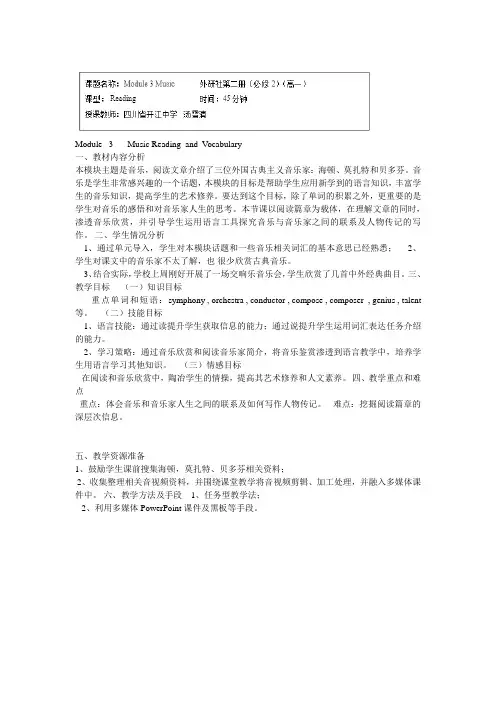
Module 3-----Music Reading and Vocabulary一、教材内容分析本模块主题是音乐,阅读文章介绍了三位外国古典主义音乐家:海顿、莫扎特和贝多芬。
音乐是学生非常感兴趣的一个话题,本模块的目标是帮助学生应用新学到的语言知识,丰富学生的音乐知识,提高学生的艺术修养。
要达到这个目标,除了单词的积累之外,更重要的是学生对音乐的感悟和对音乐家人生的思考。
本节课以阅读篇章为载体,在理解文章的同时,渗透音乐欣赏,并引导学生运用语言工具探究音乐与音乐家之间的联系及人物传记的写作。
二、学生情况分析1、通过单元导入,学生对本模块话题和一些音乐相关词汇的基本意思已经熟悉;2、学生对课文中的音乐家不太了解,也很少欣赏古典音乐。
3、结合实际,学校上周刚好开展了一场交响乐音乐会,学生欣赏了几首中外经典曲目。
三、教学目标(一)知识目标重点单词和短语:symphony , orchestra , conductor , compose , composer , genius , talent 等。
(二)技能目标1、语言技能:通过读提升学生获取信息的能力;通过说提升学生运用词汇表达任务介绍的能力。
2、学习策略:通过音乐欣赏和阅读音乐家简介,将音乐鉴赏渗透到语言教学中,培养学生用语言学习其他知识。
(三)情感目标在阅读和音乐欣赏中,陶冶学生的情操,提高其艺术修养和人文素养。
四、教学重点和难点重点:体会音乐和音乐家人生之间的联系及如何写作人物传记。
难点:挖掘阅读篇章的深层次信息。
五、教学资源准备1、鼓励学生课前搜集海顿,莫扎特、贝多芬相关资料;2、收集整理相关音视频资料,并围绕课堂教学将音视频剪辑、加工处理,并融入多媒体课件中。
六、教学方法及手段 1、任务型教学法;2、利用多媒体PowerPoint 课件及黑板等手段。
![[高一英语]Module3Music教案](https://uimg.taocdn.com/e148e917aeaad1f347933f91.webp)
Module3 Music Reading and vocabularyStep1. Lead-in〔导入〕Step2. Fast reading〔快读〕Read the passage quickly and choose the best title.1. Three Great Austrian posers2. Three Great posers of the Eighteenth Century3. Three Great Child posersStep3. Careful reading〔精读〕★ Read Part <Ⅰ> about Haydn and answer the following questions. <回答问题>1. What is Haydn known as?2. How did Haydn change the form of symphony ?3. How long did he work in eastern Austria?★ Read Part <Ⅱ> about Mozart and match the time with the right information.<信息匹配> 1〕at a very early age a. toured Europe giving concerts2〕when he was 4b. played the harpsichord in a concert for the Empress of Austria3〕when he was 5 c.showed musical talent4〕when he was 6 d. learned to play the harpsichord5〕by the time he was 14 e.started posing music6〕when he was a teenager f. posed many pieces for the harpsichord, piano and violin★ Read Part <Ⅲ > about Beethoven & decide if these sentences are true or false.〔判断正误〕1. Beethoven was born in Austria.2. Beethoven learned to play the violin and piano from his father, who was a singer.3. Beethoven met Haydn in 1781.4. Hadyn encouraged Beethoven to move to Vienna.5. When Beethoven became pletely deaf, he stopped posing.Step4. Consolidation〔巩固练习〕Three Great posers of the Eighteenth CenturyHaydn, who __ _____ __"the father of the symphony", was the son of a peasant.He________the symphony ____ a long piece for a large orchestra. ______ ______ in eastern Austria for 30 years, Haydon moved to London, _______ he was very successful.Mozart was a poser, possibly the greatest musical genius ____ ____ _____ . He had ______ ______ from a very early age. By the time he was 14, Mozart had ________ many pieces for the harpsichord, piano and violin, ____ ______ _____for orchestras. Haydn was _________with Mozart when he first met him.Beethoven was born in Bonn, Germany. He ________ musical talent when he was young. In his twenties, he met both Mozart and Haydn. However, it was Haydon who __________him to move to Vienna. ___ he grew older, he began to ___ ____. But he________ _________ .Step5. Role-playing〔角色扮演〕Work in pairs. Make a dialogue about the three posers. student A acts as an interviewer and student B acts as one of the posers.The students can make the dialogue with the following clue.Interviewer: Good morning, Mr.……poser: Good morning.Interviewer: Would you mind me asking a few questions ?poser: Of course, not. Interviewer: When……/ Where……/What…… poser: ……Interviewer: Thank you very much for your time.poser: It’s my pleasure.Step6. Homework According to the information, write a short passage about Jay Zhou.。
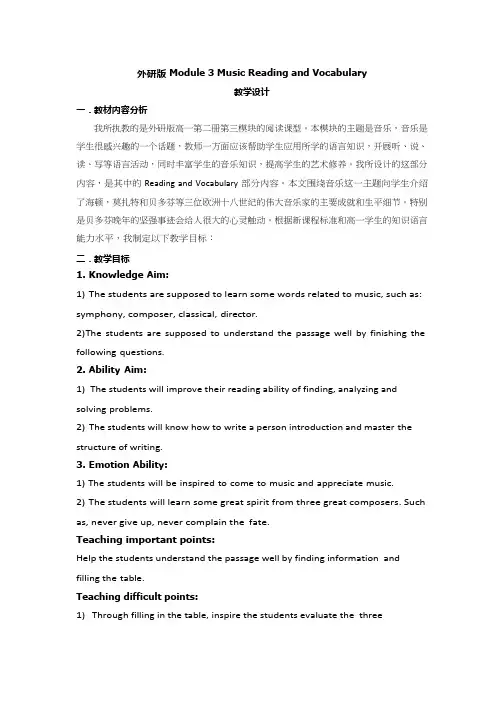
外研版Module 3 Music Reading and Vocabulary教学设计一.教材内容分析我所执教的是外研版高一第二册第三模块的阅读课型。
本模块的主题是音乐,音乐是学生很感兴趣的一个话题,教师一方面应该帮助学生应用所学的语言知识,开展听、说、读、写等语言活动,同时丰富学生的音乐知识,提高学生的艺术修养。
我所设计的这部分内容,是其中的Reading and Vocabulary 部分内容。
本文围绕音乐这一主题向学生介绍了海顿,莫扎特和贝多芬等三位欧洲十八世纪的伟大音乐家的主要成就和生平细节。
特别是贝多芬晚年的坚强事迹会给人很大的心灵触动。
根据新课程标准和高一学生的知识语言能力水平,我制定以下教学目标:二.教学目标1.Knowledge Aim:1)The students are supposed to learn some words related to music, such as: symphony, composer, classical, director.2)T he students are supposed to understand the passage well by finishing the following questions.2.Ability Aim:1)The students will improve their reading ability of finding, analyzing and solving problems.2)The students will know how to write a person introduction and master the structure of writing.3.Emotion Ability:1)The students will be inspired to come to music and appreciate music.2)The students will learn some great spirit from three great composers. Such as, never give up, never complain the fate.Teaching important points:Help the students understand the passage well by finding information and filling the table.Teaching difficult points:1)Through filling in the table, inspire the students evaluate the threecomposers and express what they have learned.2)The students master the structure of writing a person.教学过程设计Step 1. GreetingsStep 2. Lead-in (watch the video)活动:Act out the given situations and answer the question.The teacher broadcast the video.Give the following questions according to the song.1)Do you like the song ?2)Do you know who wrote this song? (引出其中的一个主人公莫扎特)1)老师播放音乐会视频营造轻松的课堂氛围,调动学生的积极性。
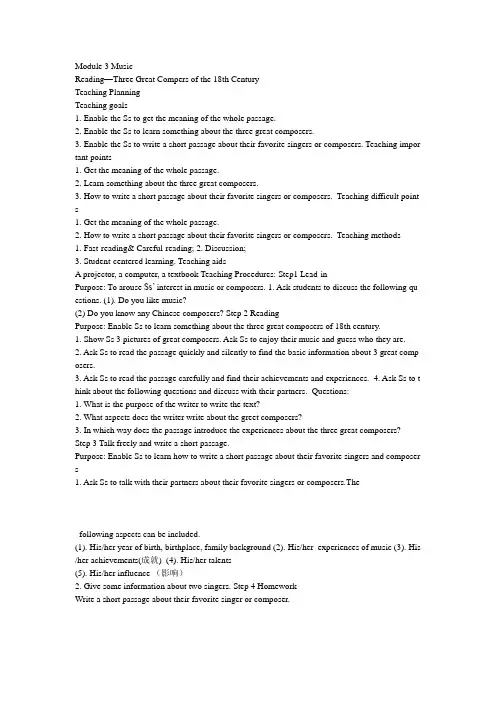
Module 3 MusicReading—Three Great Compers of the 18th CenturyTeaching PlanningTeaching goals1. Enable the Ss to get the meaning of the whole passage.2. Enable the Ss to learn something about the three great composers.3. Enable the Ss to write a short passage about their favorite singers or composers. Teaching impor tant points1. Get the meaning of the whole passage.2. Learn something about the three great composers.3. How to write a short passage about their favorite singers or composers. Teaching difficult point s1. Get the meaning of the whole passage.2. How to write a short passage about their favorite singers or composers. Teaching methods 1. Fast-reading& Careful-reading; 2. Discussion;3. Student-centered learning. Teaching aidsA projector, a computer, a textbook Teaching Procedures: Step1 Lead-inPurpose: To arouse Ss’ interest in music or composers. 1. Ask students to discuss the following qu estions. (1). Do you like music?(2) Do you know any Chinese composers? Step 2 ReadingPurpose: Enable Ss to learn something about the three great composers of 18th century.1. Show Ss 3 pictures of great composers. Ask Ss to enjoy their music and guess who they are.2. Ask Ss to read the passage quickly and silently to find the basic information about 3 great comp osers.3. Ask Ss to read the passage carefully and find their achievements and experiences.4. Ask Ss to t hink about the following questions and discuss with their partners. Questions:1. What is the purpose of the writer to write the text?2. What aspects does the writer write about the greet composers?3. In which way does the passage introduce the experiences about the three great composers? Step 3 Talk freely and write a short passage.Purpose: Enable Ss to learn how to write a short passage about their favorite singers and composer s1. Ask Ss to talk with their partners about their favorite singers or composers.Thefollowing aspects can be included.(1). His/her year of birth, birthplace, family background (2). His/her experiences of music (3). His /her achievements(成就) (4). His/her talents(5). His/her influence (影响)2. Give some information about two singers. Step 4 HomeworkWrite a short passage about their favorite singer or composer.。
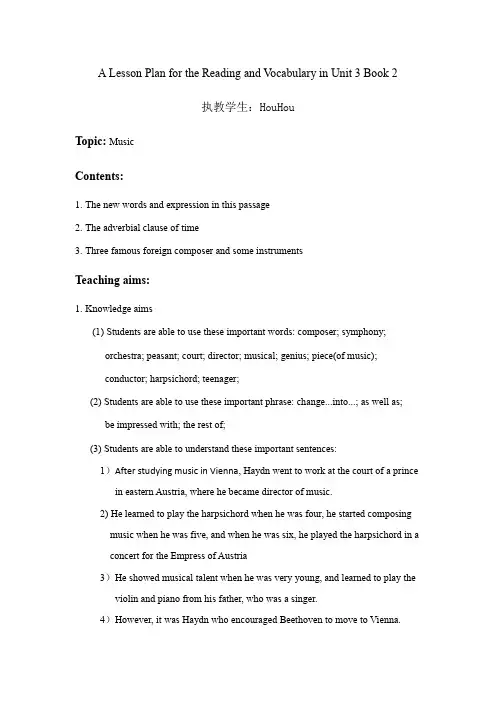
A Lesson Plan for the Reading and V ocabulary in Unit 3 Book 2执教学生:HouHouTopic: MusicContents:1.The new words and expression in this passage2.The adverbial clause of time3.Three famous foreign composer and some instrumentsTeaching aims:1.Knowledge aims(1) Students are able to use these important words: composer; symphony;orchestra; peasant; court; director; musical; genius; piece(of music);conductor; harpsichord; teenager;(2) Students are able to use these important phrase: change...into...; as well as;be impressed with; the rest of;(3) Students are able to understand these important sentences:1)After studying music in Vienna, Haydn went to work at the court of a prince in eastern Austria, where he became director of music.2) He learned to play the harpsichord when he was four, he started composingmusic when he was five, and when he was six, he played the harpsichord in aconcert for the Empress of Austria3)He showed musical talent when he was very young, and learned to play the violin and piano from his father, who was a singer.4)However, it was Haydn who encouraged Beethoven to move to Vienna.2.Ability aims(1) Listening: Students are able to understand teacher’s requests.(2) Speaking: Students are able to organize their language and talk about someworld-famous composers;(3) Reading: Students are able to understand the main idea of this passage(4) Writing: Students are able to extract the key words and write them correctly. 3.Emotional aims(1) Students are able to develope interests on music(2) Students are able to understand no matter what kind of trouble they drop in,they should still be positive and never give up.4.Culture awareness(1) Students are able to know some famous foreign composers(2) Students are able to know some instrumentsTeaching important points:1.Get the students are able to know the backgrounds and achievements of these threegreat composers: Joseph Haydn, Mozart and Beethoven, then inspire them try hard for pursuing their dream, broaden their horizon about music.2.Get the students are able to know more words about music, and are able to usethese important phrase: change...into...; as well as; be impressed with; the rest of.e the skimming and scanning to read for the general meaning and the details. Teaching difficult points:Get the students are able to understand these important sentences:1. After studying music in Vienna, Haydn went to work at the court of a princein eastern Austria, where he became director of music.2. He learned to play the harpsichord when he was four, he started composingmusic when he was five, and when he was six, he played the harpsichord in a concert for the Empress of Austria3. He showed musical talent when he was very young, and learned to play theviolin and piano from his father, who was a singer.4. However, it was Haydn who encouraged Beethoven to move to Vienna. Teaching methods:Communicative Approach and Task-based Teaching Method;Teaching aids:Books; Blackboard; Computer; Projector.Teaching procedures:Step 1 Warming-up (5 minutes)T:GreetingThen ask the students to read words listed on PPT together, to help the students review the new words , preparing for the understanding of the followingpassage reading. By the way, introduce some foreign culture to them.T: Now, please look at the screen, and read these words together. Twice oneword.Ss: ....T: Now, please look at these words. Do you know what Harpsichord is?Ss: ...T: Actually it is a kind of foreign instrument, looks like piano.I’ll show you some pictures. So this is harpsichord.T: Is Austria the same country with Australia?Ss: ....T: Many of you always confused with these two countries. Please rememberthey are totally two different countries. Let me show you a word map.Now let’s watch a video about Austria.How do you think of Austria?Ss: ....T: Yes, very beautiful. Do you want to go to Austria?Ss: ...T: Maybe someday you can travel to Austria. Now, let’s learn some music culture about Austria.Step 2 Pre-reading(5 minutes)Play three pieces of music composed by Haydn、Mozart and Beethoven one by one, then ask students who composed them, through this way, to arose students’ interests, and lead out the passage we are going to learn.T: First, Let’s enjoy some pieces of music.(play the music: 小夜曲) Do you know who’s the composer of this piece ofmusic?Ss: 海顿(Haydn)......T: wow , you guys really know so much about these three composers.Now, Let’s learn more about them.Step 3 While-reading (20 minutes)Task 1 Skimming (3 minutes)List 3 titles on the PPT screen, and give students a short time to skim thepassage, then ask students to choose a title for this passage. Through this way, enable student to skim reading and grasp the main idea of the passage.T: Please turn to page 22. There’s a passage, and I need you read it as quickly asyou can ,then choose the best tittle for this passage. 3 minutes later, gave meyour answers. Here you go.......T: Well done.Task 2 Scanning (17 minutes)Ask the students to read the passage carefully again, then exercise 1 ask the Students work in groups and answer some questions; exercise 2 to fill the blanks on PPT. Through this way, guide the students do some readingexercises, and enable them to extract the useful message.T: Now, I need you read this passage careful again. After reading, you can work in groups to have a discussion about these questions, 4 persons a group. First, let’s read these questions one by one. Ok, how about start from miss li.Ss: ....T: Do you get all these questions’ meaning?Ss: ....T: OK. You’ll have 7 minutes. Here you go.If you have finished reading, please have a discussion with your group.Ss: ....T: Ok, guys, time’s up. Have you finished? Now let’s check our answers.T: The first one, How did Haydn change the form of symphonies? Is anybody wants to share his answer with us?Ss: ....T: Do you agree with her? Very good. Let’s give her a big hand.........T: You guys really did a fantastic job.Now, I need you find answers from this passage, then fill the blanks on thePPT. You’ll have 3 minutes, have you got me?Ss: ....T: ok, guys, time’s up. Now, let’s check the answers.The first part about Haydn, who wants to have a try? Ok, Please.Please read the whole sentence.Ss: ....T: very good. Let’s clap for her. Are you all did a good job like her? Very good.......Step 4 Post-reading (10 minutes)Retell and ShareAsk the students to work in pairs and introduce one of their favorite composers to your partners. Through this way, guide the students organize their language and illustrate their ideas freely.T: Through this passage learning, I know you have know more about them.Right? Now, I need you work in pairs and introduce one of your favoriteComposers to your partners. You can introduce them according to this chart.Ss: ......T: Ok, time’s up. Who wants to share his introduction with us? Who are yourfavorite composer, ok, please.S: Haydn’s father is a peasant, and he was born in a village in Austria. After studying music in Vienna, he worked as a director of music at the court of aPrince. After working in Vienna for 30 years, he moved to London wherehe was very successful. He changed the symphony into a long piece for alarge orchestra.T: Fantastic. You really did a great job. Let’s clap for him/her, OK?......T: Through this passage, we know that they all tried hard for their dream, andthough Beethoven gradually became deaf, he still continuedhis composing and never give up, right. So we also should try hard with our dream and no matter what kind of trouble we may drop in, we should still be positive and never give up,Right?Very good.Step 5 HomeworkWrite a short passage about your favourite composer and explain the reason. Blackboard design:。
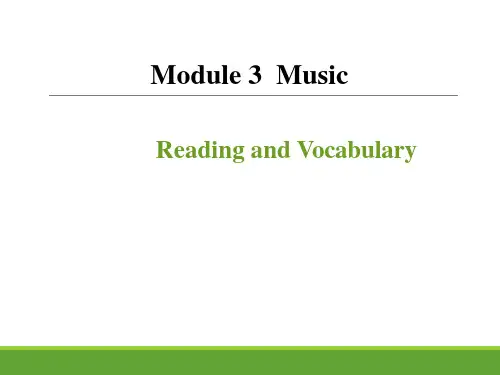

必修二Module 3 Music Reading教学设计一.设计思想本节课讲授的是高一英语外研社必修二第三模块中Reading and vocabulary(阅读课)。
本节课的设计以新课标为理念,遵循三维目标,实施有效课堂,目的是鼓励学生通过合作探究等形式,使学生能够很好的掌握本节课相关的词汇,短语,发展学生的听说读写等技能,训练和提高学生的阅读理解能力,通过生生互动,师生互动,调动学生学习的兴趣,培养学生乐观的学习态度。
二.教学目标知识目标:熟练掌握与音乐相关的词汇,并能了解与音乐和乐器相关的知识,能够看懂文章,解决与文章内容相关的的问题。
能力目标:通过精读,泛读等形式,提高学生的阅读理解;通过合作探究等形式,学生学会自主学习与合作学习。
情感目标:充分调动学生学习的热情,树立正确的人生观。
通过学习和了解三位著名音乐家的经历和作品,展示现代音乐与人类的关系,从而激发学生对音乐的热爱。
三.教学重点和难点重点:掌握本节课相关的词汇,提高学生的阅读理解能力。
难点:如何利用所学词汇解决与文章相关的问题,从而进一步的提高学生的阅读水平与应试技巧。
四. 教学过程Step 1 Revision复习:复习上一节课所学的单词。
因为在进入本单元课文之前,我已经把要点单词教授完毕。
所以,在复习的环节中,我让学生进行英语单词竞赛,让同学看着大屏,给出单词,在此过程中,要注意自己发音的准确和语流语调。
Try to guess words:1 A group of people who sing together form a _____.2 We call a large group of musicians who play together on variousinstruments an _________.3 One who directs an orchestra or other such group is a _________.4 An organized company of singers is a _____.5 People who compose music are called___________.Step 2 Lead-in导入:一节课的成败,导入环节起着一个至关重要的作用。
必修2 mudule 3 Music Reading and Vocabulary说课稿本节课为一节阅读理解课,侧重于培养学生用英语获取信息,处理信息,分析问题和解决问题的能力,同时培养学生自我完成任务的能力和策略。
一.教材分析本课是出自外研社高中英语学生用书必修2的module3 reading and vocabulary阅读课,通过介绍国外的三位音乐家及他们的伟大成就,让学生在阅读中学习音乐知识,树立正确的评价观,人生观,为日后走向社会作铺垫。
课文重点讲解了三位音乐家的生平经历,以及他们对音乐所做的极大贡献。
通过阅读,学生学习了新的词汇和句型,提高了阅读水平,并能学习音乐家们坚持不懈的精神。
二.学情分析教学对象是高一中等层次的学生,他们的英语基础尚可,但是听说技能较弱。
高中英语学习,较之初中的学习内容,存在衔接上的跨度。
因此,本节课采用了多种活动形式,尽量调动学生学习的兴趣,引导学生进行扎实有效的学习。
三.学习目标理论依据:高中英语课程标准(一)语言能力目标1.通过skimming, scanning的阅读技能提取,筛选和重组信息来理解文章主旨,把握作者写作意图,能利用上下文猜测新词汇。
2.通过复述作曲家的经历和介绍自己喜欢的歌手,提高学生运用目标语言进行表达的能力;通过对三位作曲家信息的填写培养学生在阅读过程中对语篇的整体把握能力。
(二)情感态度目标通过阅读,让学生们了解世界著名的音乐家,及他们的经历,增强他们的音乐欣赏能力和审美能力,进一步感受到音乐在生活中的意义。
(三)学习策略目标1.在阅读、课堂活动互动等完成课堂任务的过程中进行有效的自我调控。
2.训练用skimming、scanning,提高学生用英语获取、处理,分析、解决问题的能力。
3.培养学生利用上下文语境猜词的能力。
四.教学重点与难点重点:通过略读、查读阅读策略了解三位著名的作曲家。
难点:对作曲家的复述和喜爱歌手的介绍的语言表达能力;填表培养学生对语篇整理把握能力。
Module 3 Music Reading课堂教学设计一、教材内容分析这是新教材高一第二册第三模块的阅读课型,本模块的主题是音乐,音乐是学生非常感兴趣的一个话题,教师应该在帮助学生应用学到的语言知识,开展听、说、读、写等语言时间活动的同时丰富学生的音乐知识提高学生的艺术修养。
我所设计的这部分内容,是其中的阅读部分。
本文围绕音乐这一主题向学生介绍了海顿.莫扎特和贝多芬等三位欧洲十八世纪的伟大的音乐家的主要成就和生平细节。
特别是贝多芬晚年的坚强事迹会给人很大的心灵触动。
根据新课程标准以及高一学生的知识语言能力水平制定以下教学目标:二、教学目标1、知识目标:1)、重点词汇与短语Austria, Vienna, Germany, symphony, compose,composer, completely deaf, from an early age。
2)、学生了解课文内容并学习如何写作人物生平。
2、能力目标:1)、培养学生听、说、读、写的能力。
2)、培养学生合作的能力。
3)、提高学生的阅读能力,如略读、查读、细读。
3、情感目标:1)、学习贝多芬热爱事业、热爱生活的精神。
2)、学习贝多芬勇于面对困难、克服困难的精神。
3)、培养学生坚强的意志品质。
三、教学重难点:1、了解课文内容。
2、学习如何写作人物生平。
四、教学过程设计Step 1 Pre-class preparationPlay a piece of music named Qinghuaci by Jay Chou(Zhou Jielun) before class.[教师活动]播放音乐[学生活动]欣赏音乐[设计说明](1)在课前放松心情,(2)为导课做准备。
Step 2 Lead in1. Give the following questions according to the music played before class:Do you know who is the singer of the song?How much do you know about him?[设计说明]利用课前音乐,引出周杰伦也是一名作曲家,由此引出composer 这个本课的重点单词,也由此引出本课的中心话题----介绍18世纪的三位著名作曲家。
教学设计一、教材分析:本节课是出自外研版高中必修二Module 3Music 的第二节v o c a b u l a r y and reading, 该部分介绍了国外的三位音乐家及他们的伟大成就,让学生在阅读中学习音乐知识,树立正确的评价观、人生观,为日后走向社会作铺垫。
课文重点讲解了三位音乐家的生平经历,以及他们对音乐所做的巨大的贡献。
文章虽然篇幅不长,但既具备了大量的信息又集中了有用的词汇和语言语法结构。
前面的Introduction 已经介绍和呈现与乐器有关的英文词汇,为进一步学习本模块的内容奠定了基础。
该部分要求我们通过阅读世界著名的三大音乐家莫扎特,海顿和贝多芬开展教学活动,通过阅读,学生学习了新的词汇和句型,提高了阅读水平,并能学习音乐家们坚持不懈的精神。
二、学情分析:1.高一学生新到高中对高中生活学习还不适应,且基础薄弱,英语偏科生较多。
因此我在阅读教学中设置问题时,分层次时由整体到局部,由浅入深,并借助图片帮助学生理解句子、运用短语。
2.学生已初步具备用英语获取信息、处理信息、分析问题和解决问题的综合能力,但需经过练习进一步的提高。
于是我利用skimming 让学生获得整体理解并熟悉话题,利用careful reading 了解细节和重点,学生通过各种活动和小组互动等方式,解决难点问题,形成有效的学习策略。
3.由于学生对音乐这一话题比较感兴趣,且已具备一定的背景知识、经历和经验,这将有助于语言活动的开展。
但是要用英语进行思维和表达,还是有一定的难度。
于是我要求各小组在预习的基础上,提前了解自己喜欢的音乐家的生平并尽量用课文有关的词汇进行描述。
这样不仅扩大了学生的信息量,而且为本节课的阐述环节做了语言准备。
三、教学目标:1.知识目标:学习和掌握新的词汇,句型和习惯表达法。
2.能力目标:1)提高理解文章,从中获取信息,并进行分析、推理和判断的能力。
2)提高用英语进行思维和熟练表达的能力。
Module 3 Music(reading)本节课是阅读课,本文围绕音乐这一主题向学生介绍了海顿、莫扎特和贝多芬。
欧洲十八世纪的伟大的音乐家的主要成就和生平细节, 是学生感兴趣的话题。
现阶段学生已经具有一定的语言基础,具备一定的认知能力,有自我的观点和看法,对音乐会非常感兴趣,对本文一些知名的音乐家会有所了解,但对于音乐家的英文名不会太熟悉。
根据《新课标》总目标的描述,结合本课内容及学生的具体情况,我将教学目标系统化, 在语言知识目标方面,要求学生掌握并能运用本课中的主要词汇,尤其是关于音乐术语的表达方式;在语言技能方面,首先能够运用所学词汇、语言知识从主要成就和生平细节等方面介绍音乐家,第二是要培养学生获取信息、处理信息、运用信息进行推理判断的能力。
在学习策略上,首先在认知策略方面力求通过阅读培养学生抓住和辨别信息要点的能力,并能够运用用现有知识与音乐常识对材料进行理解、分析及综合加工;在调控策略方面,使学生在阅读过程中善于根据时间顺序为线索理解和撰写人物介绍类文章;在资源策略方面,通过网络或其它媒体等多种途径丰富音乐知识,提高艺术修养。
对于文化意识和情感态度目标,是要培养学生通过音乐这一特殊语言进行文化交流的意识。
使学生喜爱音乐、欣赏音乐、丰富情感。
基于以上教学目标,我设定了本节课的重难点。
教学重点是学生语言知识的习得和略读、查读等阅读微技能的训练;教学难点是如何让学生们运用所学词汇、语言恰当评价三位音乐家。
在教学方法上,本节课主要采用任务型教学法和活动教学法,并引导学生将自主学习与合作探究相结合。
教学过程设计:Step One: Lead in. 教材重组,将Introduction 作为新课导入。
1.伴随着优美的音乐,通过教师唱延安民歌,来激起学生学习的积极性,2.头脑风暴。
分组竞赛,要求学生说出有关音乐人士和乐器的词汇越多越好。
设计意图:让学生了解课文中将出现的单词或者短语,激活学生已有的知识图式,为课文学习提供语言词汇上的支撑。
必修 2 mudule 3 Music Reading and Vocabulary 说课稿本节课为一节阅读理解课,侧重于培养学生用英语获取信息,处理信息,分析问题和解决问题的能力,同时培养学生自我完成任务的能力和策略。
一.教材分析本课是出自外研社高中英语学生用书必修 2 的module3 reading and vocabulary 阅读课,通过介绍国外的三位音乐家及他们的伟大成就,让学生在阅读中学习音乐知识,树立正确的评价观,人生观,为日后走向社会作铺垫。
课文重点讲解了三位音乐家的生平经历,以及他们对音乐所做的极大贡献。
通过阅读,学生学习了新的词汇和句型,提高了阅读水平,并能学习音乐家们坚持不懈的精神。
二.学情分析教学对象是高一中等层次的学生,他们的英语基础尚可,但是听说技能较弱。
高中英语学习,较之初中的学习内容,存在衔接上的跨度。
因此,本节课采用了多种活动形式,尽量调动学生学习的兴趣,引导学生进行扎实有效的学习。
三.学习目标理论依据:高中英语课程标准(一)语言能力目标1. 通过skimming, scanning 的阅读技能提取,筛选和重组信息来理解文章主旨,把握作者写作意图,能利用上下文猜测新词汇。
2.通过复述作曲家的经历和介绍自己喜欢的歌手,提高学生运用目标语言进行表达的能力;通过对三位作曲家信息的填写培养学生在阅读过程中对语篇的整体把握能力。
(二)情感态度目标通过阅读,让学生们了解世界著名的音乐家,及他们的经历,增强他们的音乐欣赏能力和审美能力,进一步感受到音乐在生活中的意义。
(三)学习策略目标1.在阅读、课堂活动互动等完成课堂任务的过程中进行有效的自我调控。
2. 训练用skimming 、seanning,提高学生用英语获取、处理,分析、解 决问题的能力。
3. 培养学生利用上下文语境猜词的能力。
四.教学重点与难点 重点:通过略读、查读阅读策略了解三位著名的作曲家。
难点:对作曲家的复述和喜爱歌手的介绍的语言表达能力;填表培养学 生对语篇整理把握能力。
Book 2 Module 3 MusicReading and Vocabulary—Designed by Wang Hailing Teaching aims:nguage knowledge aim:On the basis of understanding the passage, students are expectedto master useful expressions and sentence patterns to describe aperson.nguage skill aim:Through various activities, students can improve basic listening,speaking, reading and writing abilities.3.E motion and attitude aim:Help students to appreciate good qualities of famous people and make full use of their own talents.4.Learning strategy aim:Through pair work and group work, help students to realize theimportance of improving abilities by working together.5.Cultural notion aim:Students will learn more about music, especially Chinese music, andlearn to introduce Chinese musicians.Important points:1.Understand the passage well by doing some exercises related to details.2.Improve students’ testing skills.3.H elp students learn how to write a composition, using what have beenlearned.4.The students should be aware that music is universal and it’s their dutyto let foreigners know about Chinese cultureDifficult points:How to let the students express their views freely and write a short passage, using what they have learned correctly.Teaching methods:1.Basic reading methods, such as skimming, scanning, intensive readingand so on.2.Pair work and group work .3.Task-oriented method.4.Arouse the students’e nthusiasm by giving them some encouragementand guidance.Teaching proceduresTask1. Learn the new words before class. Refer to a dictionary if necessary. court director genius harpsichord impressed musical peasant symphony talent composer musician orchestra classical lyrics Task 2.Read the materials about the composers背景资料库1.海顿爸爸尽管我们的大师其貌不扬,却十分善良、纯朴、幽默和平易近人,人气旺盛,因而,他的好友与崇拜者们都亲切而风趣地称他为“海顿爸爸”。
必修 2 mudule 3 Music Reading and Vocabulary 说课稿
本节课为一节阅读理解课,侧重于培养学生用英语获取信息,处理信息,分析问题和解决问题的能力,同时培养学生自我完成任务的能力和策略。
一.教材分析
本课是出自外研社高中英语学生用书必修 2 的module3 reading and vocabulary 阅读课,通过介绍国外的三位音乐家及他们的伟大成就,让学生在阅读中学习音乐知识,树立正确的评价观,人生观,为日后走向社会作铺垫。
课文重点讲解了三位音乐家的生平经历,以及他们对音乐所做的极大贡献。
通过阅读,学生学习了新的词汇和句型,提高了阅读水平,并能学习音乐家们坚持不懈的精神。
二.学情分析教学对象是高一中等层次的学生,他们的英语基础尚可,但是听说技能较弱。
高中英语学习,较之初中的学习内容,存在衔接上的跨度。
因此,本节课采用了多种活动形式,尽量调动学生学习的兴趣,引导学生进行扎实有效的学习。
三.学习目标
理论依据:高中英语课程标准
(一)语言能力目标
1. 通过skimming, scanning 的阅读技能提取,筛选和重组信息来理解文章主旨,把握作者写作意图,能利用上下文猜测新词汇。
2.通过复述作曲家的经历和介绍自己喜欢的歌手,提高学生运用目标语言进行表达的能力;通过对三位作曲家信息的填写培养学生在阅读过程中对语篇的整体把握能力。
(二)情感态度目标通过阅读,让学生们了解世界著名的音乐家,及他们的经历,增强他们的音乐欣赏能力和审美能力,进一步感受到音乐在生活中的意义。
(三)学习策略目标
1.在阅读、课堂活动互动等完成课堂任务的过程中进行有效的自我调控。
2. 训练用skimming 、seanning,提高学生用英语获取、处理,分析、解 决问题的能力。
3. 培养学生利用上下文语境猜词的能力。
四.教学重点与难点 重点:通过略读、查读阅读策略了解三位著名的作曲家。
难点:对作曲家的复述和喜爱歌手的介绍的语言表达能力;填表培养学 生对语篇整理把握能力。
五.教学辅助材料
Power point; handouts
六.教学流程
Question: 1.What do you like doing in your spare time? 2. What kind of musie do you know? Show the Ss a pieee of musie from Beethoven Have the Ss talk about Beethoven aeeording to what they've Chinese elass and introduee some new words in the passage orehestra eonduetor eomposer genius musieal) 该活动能让学生快速进入课堂学习的状态,开始思考学习的
Step 2 Reading comprehension
Fast reading
Activity 4: Go through the passage and choose the best title
Three great Austrian composers
Three great composers of the eighteenth century
Three great child composers
Activity 5: Read the passagequickly and match the information with each composer.
Salzburg, Austria be popular in the Austrian capital
Germa ny the father of the symphony
Lead-in
Step 1 Activity1: Activity2: Activity3: learned in (musician 设计意图: 主题;激发学生与主题相关的兴趣,来拓展学生的思路,从而快速进入 话题。
Haydn Mozart
Beethove n Austria the greatest musical genius
设计意图:培养学生通过快速阅读,把握文章大意的能力,并通过对信息的提取理清文章的结构。
Careful readi ng
Activity 6: Read the p assage quickly and an swer the questi ons
1.How did Haydn change the form of symphonies?
2.How long did he work in eastern Austria?
3.How many pieces of music did Mozart compose?
4.How old was he when he played for the Empress of Austria?
5.How long were Mozart and Haydn friends?
6.Who taught Beethoven how to play the piano?
7.Did he stop composing when he became deaf ?
设计意图:通过回答问题的方式加深对阅读材料的理解.
Activity 7: Find the details about the compo sers in the p assage and fill in the form.
14,_______________
__ ;being a tee
nager
in
1781,
设计意图:通过对文章内容的挖掘训练学生的细节阅读能力,从而为下面的复述作准备.
Ste P 3 Retell
Activity 8: Retell the experiences of one of composers according to the content of the form.
设计意图:通过对信息的组合培养学生重组教材的能力,以及语言表达能力.
Ste p 4 Discussi on
Activity 9: Which musicia n do you like best and why?
设计意图:开拓思维,培养学生运用语言表达情感的能力.
Step 5 Create a passage
Activity 10: Have the Ss tell us some in formatio n about his/her favourite one without giving the n ame, the n make others guess who he/she is.
设计意图:通过对人物介绍方式的概括来引导学生写作自己喜爱的歌手,培养了学生的写作能力;并通过猜一猜这种游戏方式扩大学生的参与度,从而增强对音乐的兴趣.
Step 6 Conclusion and homework
Activity 11: Have the Ss thi nk of the meaning of liste ning to music Activity 12: Write a short descri ptio n of your favourite sin ger
设计意图:主题的升华.通过对音乐的思考,让学生更加热爱音乐,去聆听音乐,感受音乐对于生活乃至生命的意义,音乐源自于生活,所以品味音乐就如同品味生活.
板书设计。